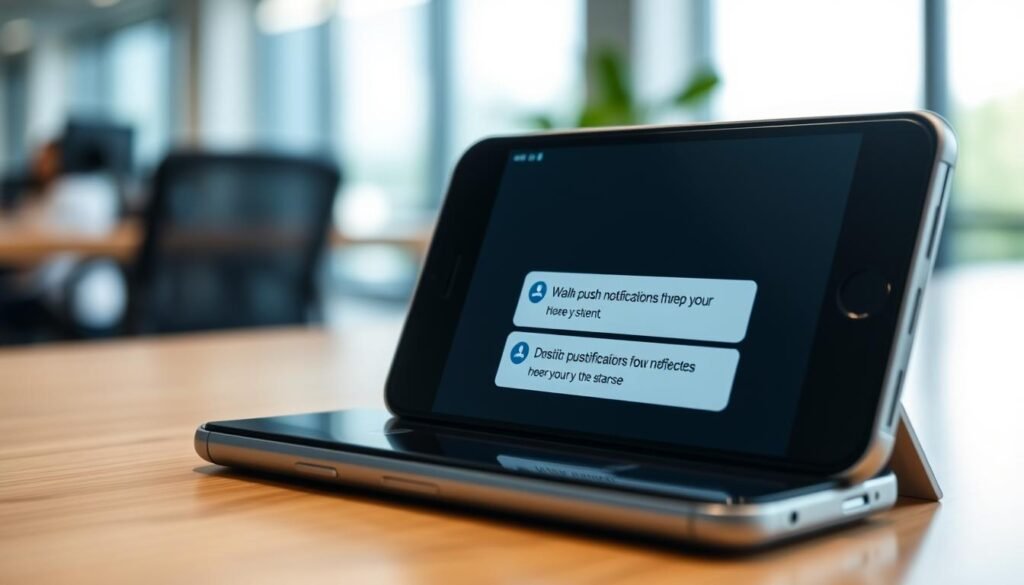This guide helps you choose the right notification channel for your next campaign. You’ll compare real-world examples that show when a push notification or an email message wins for reach, speed, and depth.
The platform supports mobile delivery via APNs and FCM and browser delivery with a service worker and tracking code. That technical context matters when you map channels to users on apps and browsers.
Notifications grab attention on lock screens and drive quick action. In contrast, email and email marketing let you tell a longer story, format content richly, and measure opens, clicks, and conversions.
This section previews a practical strategy to align media and channels to goals. You’ll learn which audiences and examples—flash sales, launches, cart recovery, or product education—fit each channel and how to test for sustained engagement.
Key Takeaways
- Notifications deliver immediacy; best for time-sensitive campaigns.
- Email provides depth for nurturing and storytelling.
- Technical setup (APNs/FCM, service workers) affects deliverability.
- Match channels to user behavior: app users, browser visitors, subscribers.
- Measure what matters: delivery and clicks for notifications; opens and conversions for email.
Why channel choice matters now: real-time notifications vs inbox depth in the United States
In the U.S., the battle for attention plays out between instant lock-screen alerts and the slower, deeper inbox experience. Seventy-five percent of Americans check their phones within five minutes of a notification, showing how quickly a short alert can trigger action.
Present-day behavior: lock-screen attention vs email engagement
Lock-screen notifications reach people when they are most receptive. Mobile alerts from APNs and FCM appear as banners or badges and can deep-link into an app for instant conversion.
By contrast, an inbox message supports longer narratives and saved reference content. That makes it better for announcements, guides, and product storytelling when you need sustained engagement.
When timeliness, personalization, and FOMO drive conversions
Timeliness wins for flash deals and limited offers. Personalization matters: tailored experiences boost retention for 62% of businesses, and 56% of shoppers return when interactions feel relevant.
- Match channel to behavior: app-active users respond faster to a notification; subscribers seek depth in the inbox.
- Measure fit: track notification view and click rates for immediacy, and open/click-to-open for inbox engagement.
- Layer media: reinforce alerts with social media and a follow-up message to deepen trust and proof.
getresponse push vs email use cases: a practical decision framework
Start by pairing campaign goals with moments that call for immediate engagement or sustained nurturing. This framework helps you choose the right channel for each stage of the customer journey.
Instant action moments
Use push notifications for flash sales, low-stock alerts, price drops, and launches where seconds matter for conversions. Brands like Domino’s and Spotify trigger timely interest and spur purchases with concise prompts.
The web push setup supports topics, action buttons, images, and scheduled sends so you can limit overload and increase click rates.
Relationship building
Email campaigns work best for welcome sequences, education, and incentive series. Templates and autoresponders let you teach product value and build trust without constant urgency.
Transactional clarity and audience fit
For confirmations and delivery status, mirror channels: send a notification for immediate reassurance (Uber Eats order updates) and an email for a detailed record.
Base choices on audience and device: app-active and browser-consenting users respond faster to notifications; segmented subscribers prefer deeper messages in the inbox. Combine both to boost conversions: a fast alert sparks action and a follow-up email nurtures later intent.
How to set up and optimize push notifications in GetResponse

Setting up reliable notifications starts with clear opt-in flows and the right delivery path for each device.
Mobile vs web delivery: Mobile delivery requires an app and OS-level consent via APNs or FCM; tapping an alert routes users into an in-app destination. Web delivery runs through the browser and needs an explicit native prompt from the site visitor.
Web push setup essentials
Create a Site in GetResponse, add the exact domain and an icon, then place the tracking code in your page head. Install the service worker file at the server root so notifications can be delivered and queued when a user is offline.
Message craft and controls
Keep headers short and action-driven. Use concise body copy, a clear button CTA, and relevant images to lift engagement. Apply topics to prevent repetitive alerts; a new notification with the same topic replaces an unread previous one.
Segmentation, testing, and analytics
Segment by behavior, location, OS, and loyalty tiers to boost relevance. Schedule around user patterns and throttle evergreen content. Track open rates, click-throughs, conversions, and unsubscriptions, and run A/B testing on one variable at a time to improve rates and long-term performance.
Executing high-performing email marketing use cases in GetResponse

To drive measurable results, pair reusable templates with autoresponders and behavior-based workflows. This approach speeds production and keeps messaging consistent across campaigns.
Build and automate:
Build and automate: templates, autoresponders, and workflows
Use drag-and-drop templates to create polished emails fast. Then chain those templates into autoresponders and workflows that trigger by behavior.
Automation scales personalization without more manual work.
Core email types: welcome, educational content, and discounts to drive action
Welcome emails set expectations and often show the highest early engagement. Educational emails teach how-tos and product benefits to shorten time-to-value. Incentive emails with clear, limited offers spur sales while protecting trust.
Landing pages and signup forms: growing the right audience for better rates
Use targeted landing pages and signup forms to attract qualified subscribers. Align form copy with campaign promises to lift downstream rates and conversions.
| Use | Goal | Trigger | Key Metric |
|---|---|---|---|
| Welcome sequence | Introduce products and services | New subscriber | Open rate / engagement |
| Educational series | Reduce time-to-first-value | Product sign-up or trial | Feature activation |
| Incentive campaign | Drive short-term sales | Behavioral trigger / promo | Conversion rate |
Cross-channel marketing strategy: combining push notifications and email for maximum impact
Orchestrate rapid alerts, long-form messages, and social media to guide attention into action. Start with a brief notification to spark interest, follow with a detailed message that explains value, and amplify via social media to broaden reach.
Orchestrated campaigns
Lead with immediate alerts for limited offers or time-sensitive sales. Then send a longer message that outlines benefits, FAQs, and next steps. Use social media posts to reinforce trust and extend reach to new audience segments.
Lifecycle examples
For launches, trigger a quick notification at go-live, then deliver a follow-up message that unpacks features. For content updates, alert users first and publish a deeper article or guide. For reactivation, start with an incentive notification and continue with a short nurturing series and social proof posts.
A/B testing across channels
Test headers, CTAs, send times, and topics across channels to find the highest converting mix. Run single-variable tests: swap a notification header, then test a different CTA in the message, and finally vary social media creative to measure incremental lift.
- Sequence smartly: send a notification at peak attention, follow with a message when users can read, then remind on social media.
- Measure holistically: track notification clicks, message click-to-open, landing conversions, and downstream sales to see true contribution.
- Protect experience: suppress follow-ups after a completed action and document triggers and fallbacks inside Marketing Automation for predictable campaigns.
For platform comparisons and deeper setup guidance, compare platforms to pick the right automation features for your strategy.
Conclusion
Choose the fastest, clearest route to action while protecting long-term customer trust.
Match channel to intent: short alerts for immediate sales and confirmations, longer messages for product education and lifecycle nurturing. Personalize content, time sends thoughtfully, and keep the path to purchase friction-free.
Operationalize both channels with tracking, topics, and button CTAs on web delivery and automated sequences for follow-up. Close the loop with clear offers, relevant discounts, and product recommendations, then confirm value with a follow-up message.
Measure what matters: compare conversion rates, purchase behavior, and customer retention across channels. Standardize winning plays inside marketing automation so your brand repeats what works and scales results.

